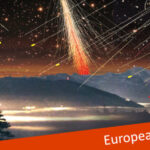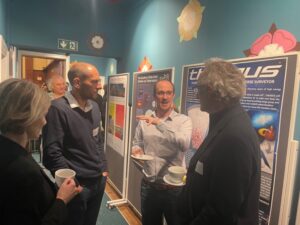
The Future of Astroparticle Physics in Europe: Presentation of the Mid-Term Update of the European Astroparticle Physics Strategy
The European Astroparticle Physics Consortium (APPEC) announces that the Mid-Term Update of the European Astroparticle Physics Strategy 2017-2026 has been successfully finalised and approved by its General Assembly. The updated roadmap was developed in collaboration with the APPEC Scientific Advisory Committee and the wider community and neighbouring disciplines. The presentation of this important update took place during an event entitled “The Future of Astroparticle Physics in Europe” where also the community presented the plans and ideas of current and future research facilities and experiments in a very lively poster session. The connections between experiment and theory as well as the synergy potential and complementarity with the astrophysics and astronomy domain were discussed at this event.
The mid-term update shows that the APPEC European Strategy for Astroparticle Physics 2017-2026 is well on track to be realised. Most of the strategic goals are on schedule and are expected to be achieved. However, it has become clear that some goals are no longer achievable, leading to adjustments in the strategic goals. At the same time, new strategic goals are emerging in other areas. Projects such as a new European gravitational wave detector (Einstein Telescope) are in an advanced stage of development. This has prompted the APPEC community to make some medium-term course adaptations in the strategic goals of various scientific astroparticle physics topics.
“Astroparticle physics uses large-scale research facilities to detect the sources and properties of messengers from the universe, which are often set up in remote locations such as on the South Pole, deep in the Mediterranean Sea, on high mountains, in the Argentinian pampas or in large underground laboratories. This implies a high need for coordination, especially in the area of data processing, as the data from these observatories must be brought together, preferably in real-time, to be of optimal use,” says Dr Andreas Haungs from KIT (Karlsruhe Institute of Technology), Chair of the APPEC General Assembly. “These large infrastructures, especially underground laboratories, are crucial to maintain and develop. An initiative for much closer co-operation between European underground laboratories is welcomed by APPEC. The resources available for the operation of existing large infrastructures, as well as for investment in those currently under construction or planned for the future, will be reviewed globally. The idea is that, despite the constant struggle for more resources, the field’s basic budget offers it a promising future.”

Poster Session during the event, ©Katharina Henjes-Kunst
“Progress in astroparticle physics goes hand in hand with profound changes in the social and societal environment of science in general and thus also of astroparticle physics. Attracting and retaining talent is increasingly becoming a challenge. Social safety in all aspects is increasingly emphasised and open science is rapidly becoming the norm. Consideration of societal impact in the widest sense is now a must. Therefore, the strategic goals for how we want to operate as scientists in astroparticle physics have become more important and clearer.” emphasised Prof. Sijbrand de Jong (Radboud University Nijmegen), who, as head of the APPEC Scientific Advisory Board, presented the roadmap update to the interested audience.
Press release:





